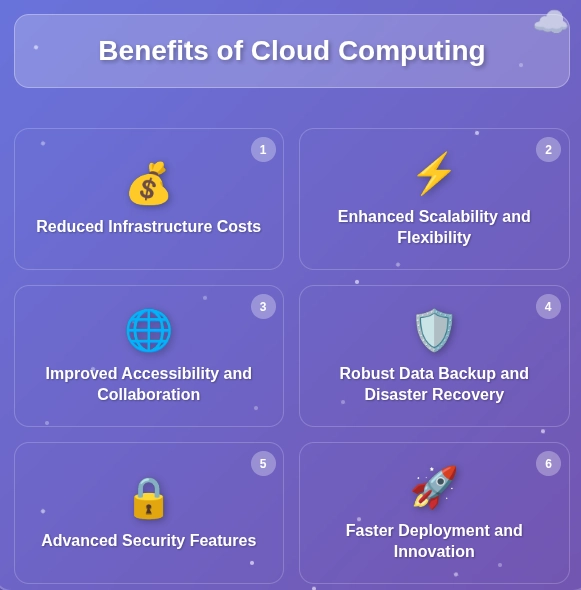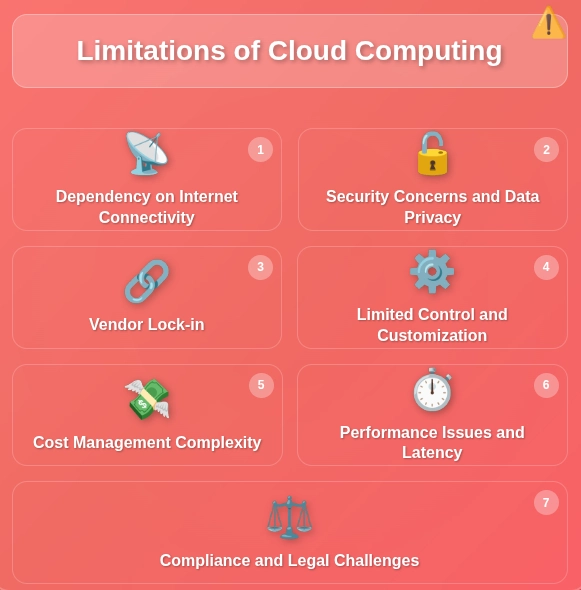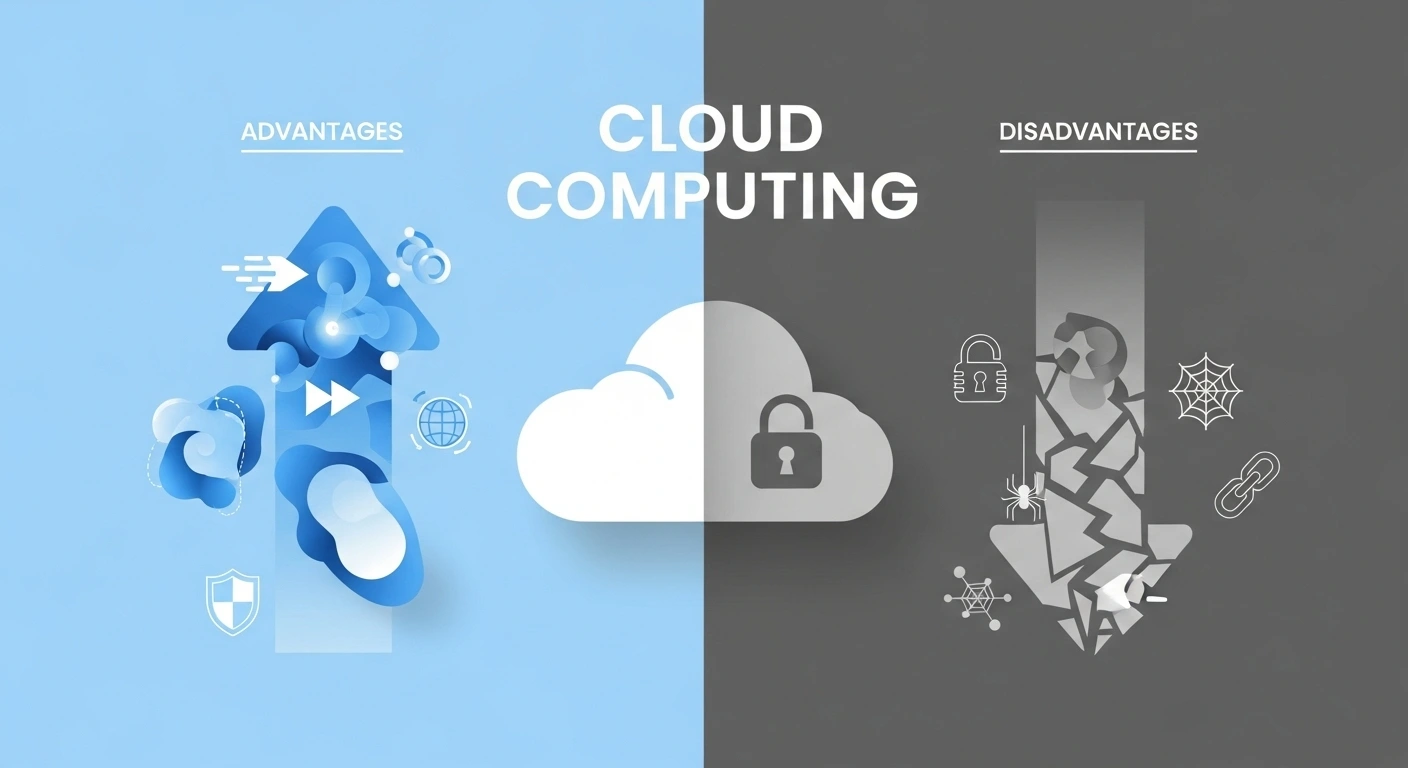Cloud computing delivers computing services over the Internet. It helps you store data, run applications, and manage resources without owning or maintaining physical infrastructure. This guide shows you how cloud computing impacts businesses. It also explains how you can maximize its benefits while managing its challenges.
The global cloud computing market was valued at $676.29 billion in 2024. It projects to grow to $2,291.59 billion by 2032. This shows a Compound Annual Growth Rate (CAGR) of 16.6%. By 2025, 96% of companies will likely use public cloud services. This growth shows cloud computing's increasing importance.
Benefits of Cloud Computing
Cloud computing gives several big benefits. These drive efficiency, cut costs, and foster innovation.

1. Reduced Infrastructure Costs
Cloud computing changes your spending from capital expenditure (CapEx) to operational expenditure (OpEx). You do not buy expensive hardware, servers, or data centers. Instead, you pay a cloud provider only for the resources you use. This is a pay-as-you-go model.
Example: Small businesses access enterprise-level services. These include data storage and advanced analytics. They pay a fraction of the cost of setting up on-premise infrastructure. This lets them use resources for core business processes. Bank of America reported $2 billion in annual savings from its AI and cloud automation initiatives. This shows big cost optimization.
Post Graduate Program in Cloud Computing by UT Austin
Master AWS, Azure & GCP in 6 months with 200+ projects & GenAI tools. Get career-ready with UT Austin’s Cloud Computing Certificate
2. Enhanced Scalability and Flexibility
Cloud environments give on-demand resource scaling. You can quickly increase or decrease compute power, storage, and networking capacity. This happens based on demand. This flexibility helps businesses adapt to changing workloads. They do not over-provision resources.
Example: Netflix uses Amazon Web Services (AWS). It hosts its large content library there. It scales smoothly during peak streaming hours. This ensures a good user experience. This happens even with millions of users active. E-commerce platforms handle huge traffic surges during holiday sales. They do this by dynamically scaling cloud resources.
3. Improved Accessibility and Collaboration
Cloud services allow users to access data and applications. They do this from any internet-connected device, anywhere. This boosts collaboration among scattered teams.
Example: Google Drive and Microsoft 365 show cloud-enabled collaboration. Teams work on shared documents, spreadsheets, and presentations in real-time. This improves productivity regardless of physical location. This is key for businesses with remote employees.
4. Robust Data Backup and Disaster Recovery
Cloud providers give integrated backup and disaster recovery solutions. Data stored in the cloud replicates across multiple data centers. This ensures business continuity. This happens even during local outages, hardware failures, or natural disasters.
Example: Companies like Vodafone use cloud-based disaster recovery. This protects critical data. If a primary data center has an issue, operations quickly switch to a replicated instance. This new instance is in a different location. This minimizes downtime and data loss. This resilience is a key benefit over traditional on-premise systems.
5. Advanced Security Features
Reputable cloud providers invest heavily in security measures. These go beyond what individual businesses can afford. They give strong encryption, identity and access management (IAM), threat detection, and continuous compliance with industry standards.
Example: Cloud providers like AWS, Azure, and Google Cloud Platform (GCP) employ dedicated security experts. They use advanced tools to protect customer data. These include multi-factor authentication, strong firewalls, and regular security audits. While no system is perfect, cloud providers give a strong security stand. Many small to medium businesses cannot achieve this alone.
6. Faster Deployment and Innovation
Cloud platforms allow rapid deployment of new services and applications. Developers quickly provision resources, test new ideas, and launch products. They do this without waiting for hardware or long setup processes. This speeds up time-to-market.
Example: Startups launch their Minimum Viable Products (MVPs) in days, not months. They do this by using cloud-native services. This agility allows them to change quickly. They gather user feedback and innovate faster. They beat competitors using traditional infrastructure.
7. Access to Emerging Technologies
Cloud providers give access to new technologies. These include Artificial Intelligence (AI), Machine Learning (ML), and Big Data analytics. They give these as managed services. This gives more access to powerful tools. These tools would otherwise need big investment and special skills.
Example: A small marketing firm uses cloud-based AI services. It analyzes customer data and personalizes marketing campaigns. This ability was once only for large enterprises. This integration allows businesses of all sizes to use advanced insights and automation.
Limitations of Cloud Computing
Cloud computing gives many benefits. But it also brings challenges organizations must face.

1. Dependency on Internet Connectivity
Cloud services need a stable and reliable internet connection. Without it, you cannot access your data or applications. This leads to possible downtime and disruption.
Example: A business much reliant on cloud-based Software as a Service (SaaS) applications may experience a complete stop in operations. This happens during an internet outage. Even short outages cause big financial losses and unhappy customers.
2. Security Concerns and Data Privacy
Cloud providers give strong security. But storing sensitive data with a third party carries risks. Data breaches, unauthorized access, and following data privacy rules (like GDPR) remain key concerns.
Example: In early 2024, National Public Data had a breach. It exposed up to 2.9 billion records. Wrong setups and human error cause 31% of cloud security breaches. Phishing affects 73% of organizations. Organizations must use their own security rules. They must also encrypt data.
3. Vendor Lock-in
Moving from one cloud provider to another is complex, costly, and takes time. This is due to differences in special services, APIs, and data transfer. This leads to "vendor lock-in."
Example: A company deeply using AWS Lambda faces big re-architecture efforts and costs. This happens if it moves functions to Google Cloud Functions or Azure Functions. This limits power in talks and flexibility.
Learn AWS Cloud fundamentals and gain hands-on experience in deploying, managing, and scaling applications on AWS.
4. Limited Control and Customization
When you use cloud services, you give up some control over the infrastructure. Cloud providers manage hardware, software updates, and patching. This limits your ability to change environments. It also limits direct action in operations.
Example: A cloud user can set up virtual machines. But they cannot physically reach the servers. They also cannot pick specific hardware parts. This concerns organizations with unique rules or very specific performance needs.
5. Cost Management Complexity
Cloud computing cuts upfront costs. But managing ongoing expenses grows complex. Hidden costs like data transfer fees (egress costs), storage overages, and charges for extra services can add up unexpectedly.
Example: A company quickly expanding data storage may get unexpected data transfer charges. This happens when moving data between regions or out of the cloud. This needs careful watching and cost optimization.
6. Performance Issues and Latency
Applications needing real-time processing or low latency face performance problems. This is due to network latency. The physical distance between users and cloud data centers causes delays. This impacts user experience.
Example: High-frequency trading platforms or real-time gaming applications need very low latency. If their users are far from cloud data centers, data transfer time slows performance. This happens even with Content Delivery Networks (CDNs).
7. Compliance and Legal Challenges
Different countries have varying data residency laws and compliance rules. Storing data across many global places with a cloud provider makes following these diverse legal frameworks hard.
Example: A European company uses a cloud provider with US data centers. It must make sure it follows both GDPR and US privacy laws. Handling these complex issues needs careful planning and strong data governance.
Strategies and Considerations
To use cloud computing well, use smart approaches. This helps manage its challenges.
Cost Optimization Strategies
Managing cloud costs is key for long-term success.
- Watch Usage and Spending: Use cloud provider tools (e.g., AWS Cost Explorer, Azure Cost Management) to track resource use. Find cost problems. This helps you understand your budget.
- Right-Size Resources: Match compute, storage, and networking resources to your workload needs. Do not over-provision. Auto-scaling mechanisms adjust resources.
- Use Reserved Instances and Savings Plans: Commit to using resources for 1 or 3 years. This gives big discounts versus on-demand pricing. This works for steady workloads.
- Manage Unused Resources: Check your cloud environment often. Find and stop idle virtual machines, unattached storage, or unused databases. These cost money even when not in use.
- Optimize Storage Tiers: Store data you use little in cheaper archival storage tiers (e.g., AWS S3 Glacier, Azure Blob Storage Cool/Archive). Do not use high-performance, more expensive options.
Example: A software company can cut its cloud costs by 30%. It can happen after setting up virtual machines correctly and buying Reserved Instances for its steady production environment.
Enhancing Cloud Security and Privacy
Strong security and privacy rules are key for cloud use.
- Use Strong Access Controls: Use Multi-Factor Authentication (MFA) for all accounts. This is especially true for special accounts. Apply the least privilege rule. Give users only needed permissions.
- Encrypt Data: Encrypt data both in transit and at rest. Cloud providers give encryption services for storage, databases, and network traffic.
- Regularly Check and Monitor: Do frequent security checks. Use cloud security posture management (CSPM) tools. Find wrong setups and weak points. 55% of organizations report human error as a main cause of breaches.
- Put Employee Training First: Human error causes 88% of cloud breaches. Train employees on cloud security rules, phishing awareness, and data handling.
- Ensure Compliance: Work with your cloud provider. Make sure you follow industry standards (e.g., HIPAA, PCI DSS) and data protection rules (e.g., GDPR, CCPA). Use tools that check GDPR compliance for your cloud systems.
Example: A healthcare provider uses a multi-layered security plan. This includes end-to-end encryption and strict access controls. It stores patient data in the cloud while following HIPAA rules.
Addressing Vendor Lock-in
Reduce vendor lock-in risks for more flexibility.
- Use a Multi-Cloud or Hybrid Cloud Strategy: Use services from many cloud providers. Or combine public cloud with your own infrastructure. This reduces reliance on one vendor. It also gives backup. 79% of organizations use a multi-cloud environment.
- Use Open Standards and APIs: When you can, pick services that follow open standards. Avoid special technologies. These tie you to one vendor.
- Containerization (e.g., Kubernetes): Put applications in containers (e.g., Docker). Manage them with platforms like Kubernetes. This makes applications easier to move across different cloud environments.
- Plan Data Portability: Plan your data moving strategy early. Understand the costs and problems of moving data. Do this if you ever need to change providers.
Example: A large enterprise used a hybrid cloud strategy. It kept sensitive data on-premises. It used public cloud for scalable web applications. They also containerized their microservices. This made moving them easier across different cloud platforms.
Human Skills and Job Market Shifts
Cloud computing adoption affects job roles. It needs workers to adapt.
- Reskill and Upskill: Invest in training for your IT staff. They need to learn cloud-specific skills. New roles in cloud architecture, DevOps, and cloud security are appearing.
- Focus on Value-Added Tasks: Automate tasks that repeat. Use cloud services for this. This frees your human workforce. They focus on more strategic, creative, and hard problem-solving. The World Economic Forum predicts 85 million jobs will change by AI and automation by 2025. But 97 million new roles will appear.
Example: Manufacturing companies use cloud-driven automation. They teach employees new skills for roles in robot programming, maintenance, and data analysis. This makes for a smooth change.
Conclusion
Cloud computing gives huge advantages. These include efficiency, scalability, and innovation. This makes it a key part of how businesses work today. But it also brings challenges. These relate to security, cost management, and vendor reliance.
To do well with cloud computing, you must understand these points. Use strong strategies for cost optimization. Make your security posture strong. Plan for flexibility. Keep learning. Adapt your workers to new cloud skills. Explore tools for cloud cost management and security monitoring now. Start optimizing your cloud environment.
What steps will you take to optimize your cloud environment after reading this?
Also Read:






